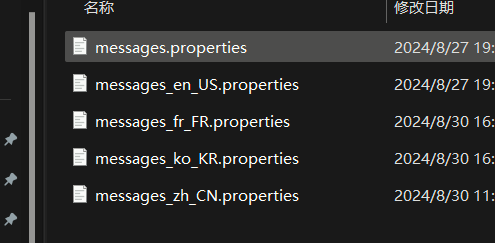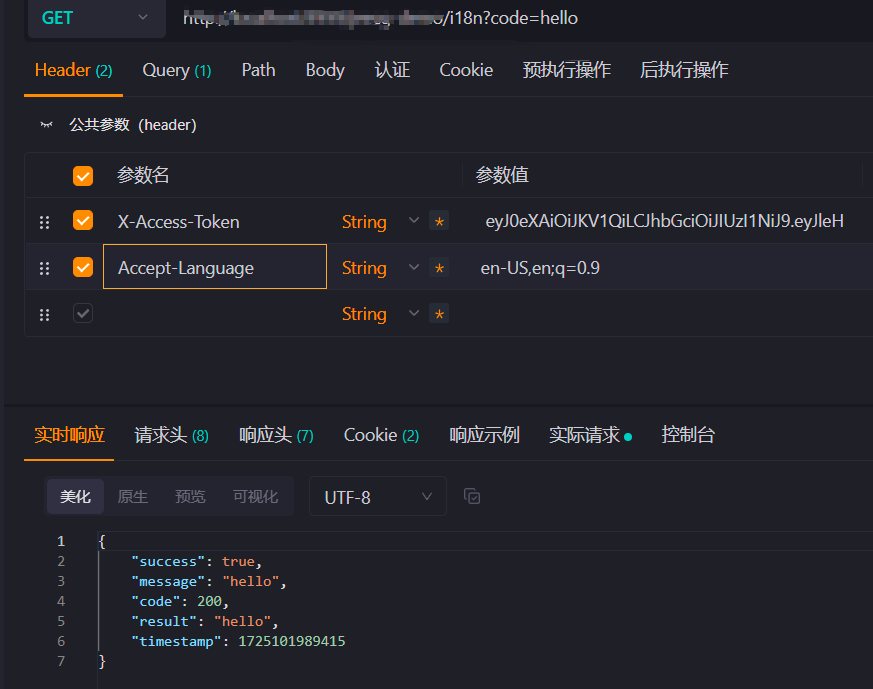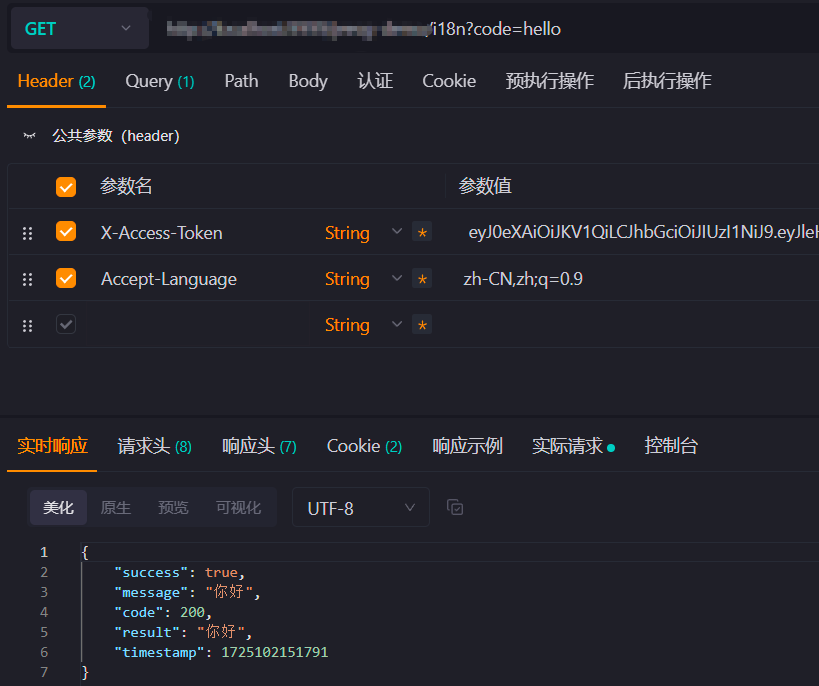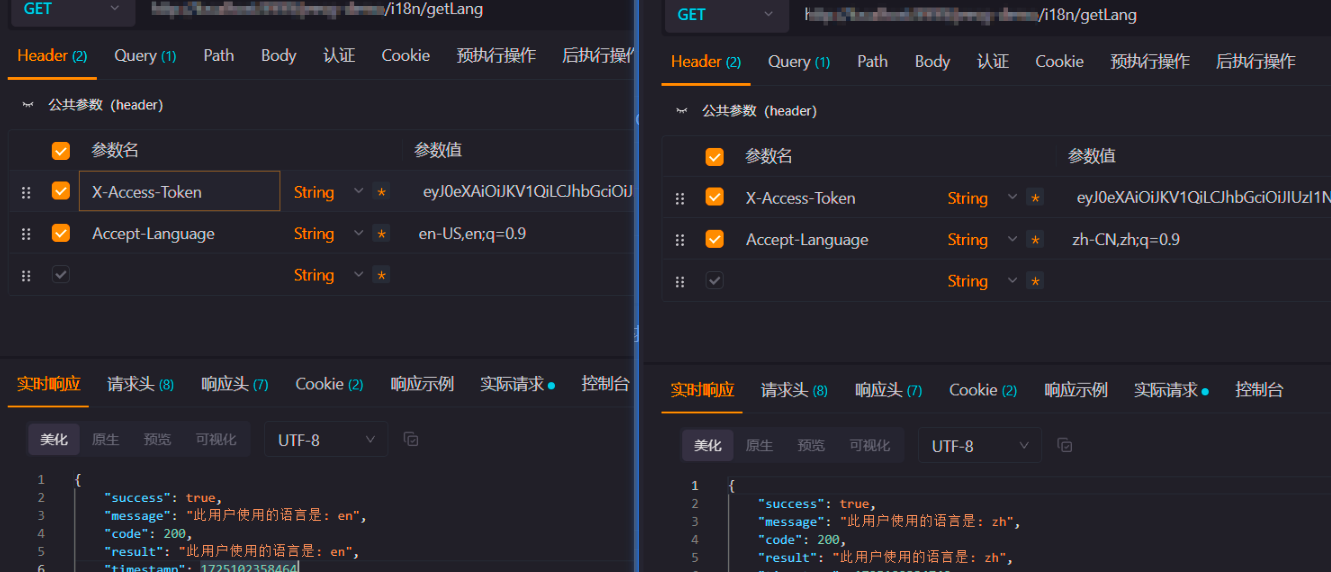SpringBoot集成国际化功能最佳实践
在构建多语言支持的 Web 应用程序时,国际化(i18n)是一个关键部分。Spring 提供了强大的国际化支持,但默认的 java.util.Locale 并不能满足所有场景的需求。为了支持更广泛的语言和区域格式,我们可以使用 ICU4J(International Components for Unicode for Java),这是一个功能强大的国际化库。
0. 准备工作
1. 创建国际化资源文件
首先需要创建或修改已有的国际化资源文件。这些文件通常放在项目的 src/main/resources/i18n/ 目录下。对于不同的语言,你可以创建对应的属性文件,例如:
- messages.properties - 默认
- messages_en_US.properties - 英语
- messages_zh_CN.properties - 简体中文
示例文件内容:

messages.properties
1welcome=欢迎
2hello=你好
messages_zh_CN.properties
1welcome=欢迎
2hello=你好
messages_en_US.properties
1welcome=Welcom
2hello=Hello
2. 配置 Spring Boot 应用
为了使Spring Boot能够识别这些资源文件,你需要在配置文件中指定国际化配置。可以在 application.yml 或 application.properties 文件中添加如下配置:
# application.yml
spring:
messages:
basename: i18n/messages
# application.properties
spring.messages.basename=i18n/messages
1. 引入 ICU4J 依赖
<dependency>
<groupId>com.ibm.icu</groupId>
<artifactId>icu4j</artifactId>
<version>75.1</version>
</dependency>
2. 使用 ICU4J 替代 java.util.Locale
ICU4J 提供了更丰富的国际化功能,相较于标准的 java.util.Locale,它支持更多的区域设置和更灵活的语言环境处理。我们可以使用 ULocale 来替代 Locale,并通过自定义过滤器 ULocaleFilter 来在每个请求中解析 Accept-Language 头部,设置用户的语言环境。
import com.ibm.icu.util.ULocale;
import lombok.extern.slf4j.Slf4j;
import org.springframework.stereotype.Component;
import javax.servlet.Filter;
import javax.servlet.FilterChain;
import javax.servlet.FilterConfig;
import javax.servlet.ServletException;
import javax.servlet.ServletRequest;
import javax.servlet.ServletResponse;
import javax.servlet.http.HttpServletRequest;
import java.io.IOException;
import java.util.ArrayList;
import java.util.List;
import java.util.Map;
import java.util.TreeMap;
/**
* 国际化过滤器
*
* @author fanfan
*/
@Slf4j
@Component
public class ULocaleFilter implements Filter {
@Override
public void doFilter(ServletRequest request, ServletResponse response, FilterChain chain) throws IOException, ServletException {
HttpServletRequest httpRequest = (HttpServletRequest) request;
String acceptLanguage = httpRequest.getHeader("Accept-Language");
if (acceptLanguage != null && !acceptLanguage.isEmpty()) {
ULocale uLocale = determineBestULocale(acceptLanguage);
log.info("这个用户的语言是: {}", uLocale.getLanguage());
log.info("这个用户的国家是: {}", uLocale.getCountry());
log.info("这个用户的语言环境的完整名称是: {}", uLocale.getDisplayName());
ULocaleContextHolder.setULocaleContext(new ULocaleContext(uLocale));
} else {
ULocaleContextHolder.setULocaleContext(new ULocaleContext(ULocale.US));
log.info("没有找到用户的语言信息,使用默认: 美国英文");
}
try {
chain.doFilter(request, response);
} finally {
ULocaleContextHolder.resetULocaleContext();
}
}
private ULocale determineBestULocale(String acceptLanguage) {
String[] locales = acceptLanguage.split(",");
Map<Double, List<ULocale>> weightedLocales = new TreeMap<>((a, b) -> b.compareTo(a)); // 按权重从高到低排序
for (String localeStr : locales) {
String[] parts = localeStr.trim().split(";q=");
ULocale locale = ULocale.forLanguageTag(parts[0]);
double weight = parts.length > 1 ? Double.parseDouble(parts[1]) : 1.0;
weightedLocales.computeIfAbsent(weight, k -> new ArrayList<>()).add(locale);
}
return weightedLocales.values().stream().flatMap(List::stream).findFirst().orElse(ULocale.getDefault());
}
@Override
public void init(FilterConfig filterConfig) throws ServletException {
// 初始化配置
}
@Override
public void destroy() {
// 销毁过滤器
}
}
3. 线程工具类 用来保存国际化信息
import com.ibm.icu.util.ULocale;
public class ULocaleContext {
private final ULocale uLocale;
public ULocaleContext(ULocale uLocale) {
this.uLocale = uLocale;
}
public ULocale getULocale() {
return uLocale;
}
}
import com.ibm.icu.util.ULocale;
public class ULocaleContextHolder {
private static final ThreadLocal<ULocaleContext> localeContextHolder = new ThreadLocal<>();
public static void setULocaleContext(ULocaleContext context) {
localeContextHolder.set(context);
}
public static ULocaleContext getULocaleContext() {
return localeContextHolder.get();
}
public static ULocale getULocale() {
ULocaleContext context = getULocaleContext();
return (context != null ? context.getULocale() : ULocale.getDefault());
}
public static void resetULocaleContext() {
localeContextHolder.remove();
}
}
4. 创建 I18nUtils 用于业务中调用
import cn.hutool.extra.spring.SpringUtil;
import com.ibm.icu.util.ULocale;
import lombok.AccessLevel;
import lombok.NoArgsConstructor;
import org.springframework.context.MessageSource;
import org.springframework.context.NoSuchMessageException;
/**
* i18n 国际化工具
*
* @author fanfan
*/
@NoArgsConstructor(access = AccessLevel.PRIVATE)
public class I18nUtils {
private static final MessageSource MESSAGE_SOURCE = SpringUtil.getBean(MessageSource.class);
/**
* 根据消息键和参数 获取消息 委托给spring messageSource
*
* @param code 消息键
* @param args 参数
* @return 获取国际化翻译值
*/
public static String message(String code, Object... args) {
try {
ULocale uLocale = ULocaleContextHolder.getULocale();
return MESSAGE_SOURCE.getMessage(code, args, uLocale.toLocale());
} catch (NoSuchMessageException e) {
return code;
}
}
/**
* 获取当前语言
* @return 语言
*/
public static String getLanguage() {
ULocale uLocale = ULocaleContextHolder.getULocale();
return uLocale.getLanguage();
}
}

5. 编写测试 controller 进行测试
import io.swagger.annotations.ApiOperation;
import lombok.Data;
import org.hibernate.validator.constraints.Range;
import org.jeecg.common.api.vo.Result;
import org.jeecg.config.i18n.I18nUtils;
import org.springframework.validation.annotation.Validated;
import org.springframework.web.bind.annotation.GetMapping;
import org.springframework.web.bind.annotation.RequestMapping;
import org.springframework.web.bind.annotation.RestController;
import javax.validation.constraints.NotBlank;
import javax.validation.constraints.NotNull;
/**
* 测试国际化
*
* @author fanfan
*/
@RestController
@RequestMapping("/i18n")
public class TestI18nController {
/**
* 通过code获取国际化内容
*
* @param code 国际化code
*/
@ApiOperation(value = "国际化测试")
@GetMapping()
public Result<Void> get(String code) {
return Result.ok(I18nUtils.message(code));
}
/**
* 获取当前语言
*/
@ApiOperation(value = "国际化测试获取对应语言")
@GetMapping("/getLang")
public Result<Void> getLang() {
return Result.ok("此用户使用的语言是: " + I18nUtils.getLanguage());
}
}
在 ApiPost中进行接口测试
测试国际化
下面是一个简化的示例表格,展示了不同国家和地区常用的 Accept-Language 设置。请注意,实际使用中,这些值可能会根据用户的个人设置有所不同。
| 国家/地区 | 典型的 Accept-Language 值 |
|---|---|
| 美国 | en-US,en;q=0.9 |
| 加拿大(英语区) | en-CA,en;q=0.9 |
| 加拿大(法语区) | fr-CA,fr;q=0.9 |
| 英国 | en-GB,en;q=0.9 |
| 澳大利亚 | en-AU,en;q=0.9 |
| 新西兰 | en-NZ,en;q=0.9 |
| 南非 | en-ZA,en;q=0.9 |
| 中国 | zh-CN,zh;q=0.9 |
| 台湾 | zh-TW,zh;q=0.9 |
| 香港 | zh-HK,zh;q=0.9 |
| 日本 | ja-JP,ja;q=0.9 |
| 韩国 | ko-KR,ko;q=0.9 |
| 德国 | de-DE,de;q=0.9 |
| 法国 | fr-FR,fr;q=0.9 |
| 西班牙 | es-ES,es;q=0.9 |
| 俄罗斯 | ru-RU,ru;q=0.9 |
| 巴西 | pt-BR,pt;q=0.9 |
| 葡萄牙 | pt-PT,pt;q=0.9 |
| 意大利 | it-IT,it;q=0.9 |
| 荷兰 | nl-NL,nl;q=0.9 |
这里的 q 参数表示“质量”或优先级,q=0.9 表示该语言的优先级为0.9,通常默认值是1.0。例如,“en-US,en;q=0.9”意味着首先偏好美国英语(en-US),但如果不可用,则接受通用英语(en),其优先级稍低。
请注意,这些值并不是固定的,它们可以根据用户的浏览器设置和偏好而变化。
根据请求头调整 Accept-Language 为 美国英语 对应的区域标准代码是 en-US,en;q=0.9

根据请求头调整 Accept-Language 为 中国简中 对应的区域标准代码是 zh-CN,zh;q=0.9

获取对应语言信息测试

现在就完成了最基本的国际化,后续就可以使用 I18nUtils 的对应国际化消息了
6. 扩展
对异常消息的处理
public static boolean verifyToken(String token, CommonAPI commonApi, RedisUtil redisUtil) {
if (StringUtils.isBlank(token)) {
throw new JeecgBoot401Exception(I18nUtils.message("token.null"));
}
// 解密获得username,用于和数据库进行对比
String username = JwtUtil.getUsername(token);
if (username == null) {
throw new Exception(I18nUtils.message("token.expired"));
}
// 查询用户信息
LoginUser user = TokenUtils.getLoginUser(username, commonApi, redisUtil);
//LoginUser user = commonApi.getUserByName(username);
if (user == null) {
throw new Exception(I18nUtils.message("user.password.not.match"));
}
// 判断用户状态
if (user.getStatus() != 1) {
throw new Exception(I18nUtils.message("user.blocked"));
}
// 校验token是否超时失效 & 或者账号密码是否错误
if (!jwtTokenRefresh(token, username, user.getPassword(), redisUtil)) {
throw new Exception(I18nUtils.message("token.expired"));
}
return true;
}
这样,根据客户端发送的语言设置,页面上将显示相应的语言版本。
以上就是基本的国际化配置方法,你可以根据实际需求调整配置和实现细节。
如果您有需要,可联系我 发您完整示例代码